- Accueil
- Pages cachées
- 14 FEVRIER 2024 NEWS
14 FEVRIER 2024 NEWS
INSTITUT SUPERIEUR D'ANTHROPOLOGIE
INSTITUTE OF ANTHROPOLOGY
ONLINE COURSES / COURS A DISTANCE
INSCRIPTIONS OUVERTES
REGISTER NOW
CHINE -  Puyang - Bone slips used for “fortune-telling activities” and “ancient sacrificial ceremonies” were unearthed during excavations at an archaeological site in Puyang, Central China’s Henan Province. This archaeological site in Puyang, Central China’s Henan Province, was recently revealed to be an ancient Chinese city known as “Gan” from the Warring States Period (475BC-221BC) to the Han Dynasty (206BC-AD220). A grand wall separates the ancient ruins into two sections. More than 40 ancient tombs have been found. With similar long and narrow designs, these tombs have yielded many burial artifacts, including chess pieces, pottery, and bronze mirrors. Archaeologist Qu Fulin told the Global Times that based on the tombs’ long and narrow configuration as well as the abundant pottery and bronze relics, they “were very likely built during the Han, particularly the Western Han Dynasty [206BC-AD25].” The rarest and most surprising item discovered among the site’s relics is a batch of bone slips, totaling 10 pieces. Each was inscribed with the ancient Chinese ordinal system known as the Ten Heavenly Stems and Twelve Earthly Branches, or Tiangan (Dizhi) in Chinese. The remains of cinnabar paint were found on the surface of these bone slips. The Heavenly Stems and Earthly Branches are ancient China’s systems of keeping time. These two counting systems, originally based on sky observations, became very influential in many aspects of daily life in China and spread to other parts of Asia. These two systems have been in use since nearly the beginning of recorded history in China, during the Shang Dynasty. Archaeologists discovered a piece of oracle bone from 1000 BC that had been carved with the complete sexagenary cycle, which consisted of Heavenly Stems and Earthly Branches. Although many people believe that this is a rudimentary calendar used by the Shang rulers, some scholars disagree. For example, Xiong Gang, an expert on Chinese folk culture, told the Global Times that due to the precious nature of bone as a carving material, those slips were unlikely to have been used as a calendar despite the presence of the 10 Heavenly Stems and 12 Earthly Branches, which were mainly associated with ancient Chinese astronomical calendars. Those bone slips were most likely objects used for “fortune-telling activities” and “ancient sacrificial ceremonies,” Xiong emphasized. He also added that those bone slips were “often made of the bones of animals like oxen,” and they were very representative of Western Han Dynasty culture.
Puyang - Bone slips used for “fortune-telling activities” and “ancient sacrificial ceremonies” were unearthed during excavations at an archaeological site in Puyang, Central China’s Henan Province. This archaeological site in Puyang, Central China’s Henan Province, was recently revealed to be an ancient Chinese city known as “Gan” from the Warring States Period (475BC-221BC) to the Han Dynasty (206BC-AD220). A grand wall separates the ancient ruins into two sections. More than 40 ancient tombs have been found. With similar long and narrow designs, these tombs have yielded many burial artifacts, including chess pieces, pottery, and bronze mirrors. Archaeologist Qu Fulin told the Global Times that based on the tombs’ long and narrow configuration as well as the abundant pottery and bronze relics, they “were very likely built during the Han, particularly the Western Han Dynasty [206BC-AD25].” The rarest and most surprising item discovered among the site’s relics is a batch of bone slips, totaling 10 pieces. Each was inscribed with the ancient Chinese ordinal system known as the Ten Heavenly Stems and Twelve Earthly Branches, or Tiangan (Dizhi) in Chinese. The remains of cinnabar paint were found on the surface of these bone slips. The Heavenly Stems and Earthly Branches are ancient China’s systems of keeping time. These two counting systems, originally based on sky observations, became very influential in many aspects of daily life in China and spread to other parts of Asia. These two systems have been in use since nearly the beginning of recorded history in China, during the Shang Dynasty. Archaeologists discovered a piece of oracle bone from 1000 BC that had been carved with the complete sexagenary cycle, which consisted of Heavenly Stems and Earthly Branches. Although many people believe that this is a rudimentary calendar used by the Shang rulers, some scholars disagree. For example, Xiong Gang, an expert on Chinese folk culture, told the Global Times that due to the precious nature of bone as a carving material, those slips were unlikely to have been used as a calendar despite the presence of the 10 Heavenly Stems and 12 Earthly Branches, which were mainly associated with ancient Chinese astronomical calendars. Those bone slips were most likely objects used for “fortune-telling activities” and “ancient sacrificial ceremonies,” Xiong emphasized. He also added that those bone slips were “often made of the bones of animals like oxen,” and they were very representative of Western Han Dynasty culture.
https://arkeonews.net/ancient-city-site-unearthed-in-central-china-produces-fortune-telling-relics/
CHILI – 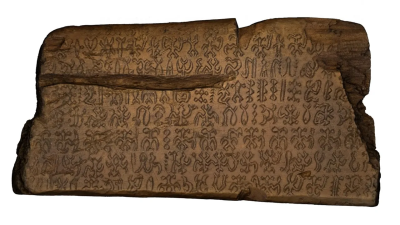 Rapa Nui - From the depths of history, a wooden tablet bearing the mysterious “rongorongo” script has been unearthed from the small, remote island of Rapa Nui (also called Easter Island). This discovery, detailed in a study published in Scientific Reports on February 2nd, provides compelling evidence that the origins of this script predate European contact by more than two centuries, challenging previously held assumptions about its origins. According to experts, this discovery supports the theory that the rongorongo script is one of the few independently invented writing systems. The wooden tablet, along with three others, is part of a collection in Rome. The tablet was among four tablets retrieved by Catholic missionaries in 1869. Recent radiocarbon dating conducted on these tablets at the University of Bologna has shed light on their origins. Remarkably, the wood of one tablet was determined to have been cut down between 1493 and 1509, a significant timeframe preceding the European arrival in the 1720s. Rapa Nui, which sits nearly 2,400 miles (3,800 kilometers) off the coast of Chile, was settled by humans between 1150 and 1280. Although Europeans arrived in the 18th century, they didn’t notice the local glyph-based script until 1864. The complex glyphs of the Rongorongo script are unlike any writing system found in Europe, suggesting it was an original creation by the Rapa Nui people. There are 27 wooden tablets with roughly 15,000 characters and more than 400 different glyphs among the rongorongo inscriptions that have survived. However, deciphering this ancient language remains a perplexing mystery. Only 27 tablets inscribed with the intricate but undeciphered rongorongo script have survived, totaling approximately 15,000 characters and over 400 different glyphs. Image credit: INSCRIBE and RESOLUTION ERC Teams The analysis also revealed that the wood on the oldest tablet came from a non-native tree species, possibly driftwood. This discovery raises questions about the island’s ecological past and the resources available to its ancient inhabitants. If additional research confirms that the Rongorongo script predates European contact, it would be yet another independent invention of writing in human history. This would put the Rapa Nui people in the same league as theRapa Nui is famous for its archaeological mysteries, including the massive stone heads known as moai, and many people have attempted — but failed — to decipher the rongorongo script. “Historically speaking, if you borrow a writing system, then you keep it as close to the original as possible,” study lead author Silvia Ferrara, a philologist from the University of Bologna, said in an interview with Live Science. Rafal Wieczorak, a chemist from the University of Warsaw who has studied other Easter Island tablets with Rongorongo writing on them, is excited about the implications of the dating results obtained by the German and Italian scientists. Namely, the implication that European contact had nothing to do with the script’s invention. But he also notes that further research will be needed to prove the case conclusively. The wooden tablet, with its undeciphered script, stands as a symbol of the mysteries that continue to captivate us. Sumerians, Egyptians, and Chinese, all of whom developed their own unique writing systems.
Rapa Nui - From the depths of history, a wooden tablet bearing the mysterious “rongorongo” script has been unearthed from the small, remote island of Rapa Nui (also called Easter Island). This discovery, detailed in a study published in Scientific Reports on February 2nd, provides compelling evidence that the origins of this script predate European contact by more than two centuries, challenging previously held assumptions about its origins. According to experts, this discovery supports the theory that the rongorongo script is one of the few independently invented writing systems. The wooden tablet, along with three others, is part of a collection in Rome. The tablet was among four tablets retrieved by Catholic missionaries in 1869. Recent radiocarbon dating conducted on these tablets at the University of Bologna has shed light on their origins. Remarkably, the wood of one tablet was determined to have been cut down between 1493 and 1509, a significant timeframe preceding the European arrival in the 1720s. Rapa Nui, which sits nearly 2,400 miles (3,800 kilometers) off the coast of Chile, was settled by humans between 1150 and 1280. Although Europeans arrived in the 18th century, they didn’t notice the local glyph-based script until 1864. The complex glyphs of the Rongorongo script are unlike any writing system found in Europe, suggesting it was an original creation by the Rapa Nui people. There are 27 wooden tablets with roughly 15,000 characters and more than 400 different glyphs among the rongorongo inscriptions that have survived. However, deciphering this ancient language remains a perplexing mystery. Only 27 tablets inscribed with the intricate but undeciphered rongorongo script have survived, totaling approximately 15,000 characters and over 400 different glyphs. Image credit: INSCRIBE and RESOLUTION ERC Teams The analysis also revealed that the wood on the oldest tablet came from a non-native tree species, possibly driftwood. This discovery raises questions about the island’s ecological past and the resources available to its ancient inhabitants. If additional research confirms that the Rongorongo script predates European contact, it would be yet another independent invention of writing in human history. This would put the Rapa Nui people in the same league as theRapa Nui is famous for its archaeological mysteries, including the massive stone heads known as moai, and many people have attempted — but failed — to decipher the rongorongo script. “Historically speaking, if you borrow a writing system, then you keep it as close to the original as possible,” study lead author Silvia Ferrara, a philologist from the University of Bologna, said in an interview with Live Science. Rafal Wieczorak, a chemist from the University of Warsaw who has studied other Easter Island tablets with Rongorongo writing on them, is excited about the implications of the dating results obtained by the German and Italian scientists. Namely, the implication that European contact had nothing to do with the script’s invention. But he also notes that further research will be needed to prove the case conclusively. The wooden tablet, with its undeciphered script, stands as a symbol of the mysteries that continue to captivate us. Sumerians, Egyptians, and Chinese, all of whom developed their own unique writing systems.
CHINE - 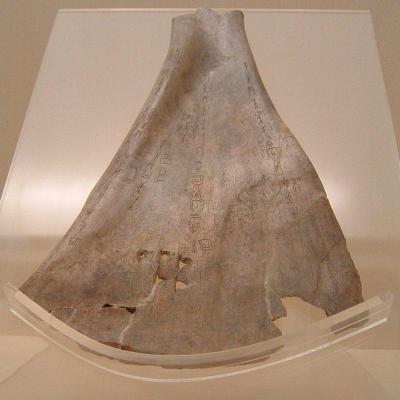 Puyang - This archaeological site in Puyang was recently revealed to be an ancient Chinese city known as “Gan” from the Warring States Period (475BC-221BC) to the Han Dynasty (206BC-AD220). A grand wall separates the ancient ruins into two sections. More than 40 ancient tombs have been found. With similar long and narrow designs, these tombs have yielded many burial artifacts, including chess pieces, pottery, and bronze mirrors. Archaeologist Qu Fulin told the Global Times that based on the tombs’ long and narrow configuration as well as the abundant pottery and bronze relics, they “were very likely built during the Han, particularly the Western Han Dynasty [206BC-AD25].” The rarest and most surprising item discovered among the site’s relics is a batch of bone slips, totaling 10 pieces. Each was inscribed with the ancient Chinese ordinal system known as the Ten Heavenly Stems and Twelve Earthly Branches, or Tiangan (Dizhi) in Chinese. The remains of cinnabar paint were found on the surface of these bone slips. The Heavenly Stems and Earthly Branches are ancient China’s systems of keeping time. These two counting systems, originally based on sky observations, became very influential in many aspects of daily life in China and spread to other parts of Asia. These two systems have been in use since nearly the beginning of recorded history in China, during the Shang Dynasty. Archaeologists discovered a piece of oracle bone from 1000 BC that had been carved with the complete sexagenary cycle, which consisted of Heavenly Stems and Earthly Branches. Although many people believe that this is a rudimentary calendar used by the Shang rulers, some scholars disagree. For example, Xiong Gang, an expert on Chinese folk culture, told the Global Times that due to the precious nature of bone as a carving material, those slips were unlikely to have been used as a calendar despite the presence of the 10 Heavenly Stems and 12 Earthly Branches, which were mainly associated with ancient Chinese astronomical calendars. Those bone slips were most likely objects used for “fortune-telling activities” and “ancient sacrificial ceremonies,” Xiong emphasized. He also added that those bone slips were “often made of the bones of animals like oxen,” and they were very representative of Western Han Dynasty culture. Oracle bones are animal bones that were used in ancient Chinese divination ceremonies. They are commonly made from an ox scapula bone or the lower side of a tortoiseshell. The oracle bone divination ceremony was a way to seek guidance from deities or ancestors. People sought advice on topics ranging from military strategy, the harvest, childbirth, and hunting, to the cause of the king’s toothache. The history of the city of Gan was also revealed after the archaeological site was excavated.It was an ancient regime that was once a vassal state dating back to the Western Zhou Dynasty. Similar to the city, there was another ancient city called “Qi” dating back to the Spring and Autumn Period (770BC-476BC) that was also founded in Puyang. “The discovered ancient city also sheds light on studies into the urban planning and construction systems of the Han Dynasty,” archaeologist Qu Fulin said.
Puyang - This archaeological site in Puyang was recently revealed to be an ancient Chinese city known as “Gan” from the Warring States Period (475BC-221BC) to the Han Dynasty (206BC-AD220). A grand wall separates the ancient ruins into two sections. More than 40 ancient tombs have been found. With similar long and narrow designs, these tombs have yielded many burial artifacts, including chess pieces, pottery, and bronze mirrors. Archaeologist Qu Fulin told the Global Times that based on the tombs’ long and narrow configuration as well as the abundant pottery and bronze relics, they “were very likely built during the Han, particularly the Western Han Dynasty [206BC-AD25].” The rarest and most surprising item discovered among the site’s relics is a batch of bone slips, totaling 10 pieces. Each was inscribed with the ancient Chinese ordinal system known as the Ten Heavenly Stems and Twelve Earthly Branches, or Tiangan (Dizhi) in Chinese. The remains of cinnabar paint were found on the surface of these bone slips. The Heavenly Stems and Earthly Branches are ancient China’s systems of keeping time. These two counting systems, originally based on sky observations, became very influential in many aspects of daily life in China and spread to other parts of Asia. These two systems have been in use since nearly the beginning of recorded history in China, during the Shang Dynasty. Archaeologists discovered a piece of oracle bone from 1000 BC that had been carved with the complete sexagenary cycle, which consisted of Heavenly Stems and Earthly Branches. Although many people believe that this is a rudimentary calendar used by the Shang rulers, some scholars disagree. For example, Xiong Gang, an expert on Chinese folk culture, told the Global Times that due to the precious nature of bone as a carving material, those slips were unlikely to have been used as a calendar despite the presence of the 10 Heavenly Stems and 12 Earthly Branches, which were mainly associated with ancient Chinese astronomical calendars. Those bone slips were most likely objects used for “fortune-telling activities” and “ancient sacrificial ceremonies,” Xiong emphasized. He also added that those bone slips were “often made of the bones of animals like oxen,” and they were very representative of Western Han Dynasty culture. Oracle bones are animal bones that were used in ancient Chinese divination ceremonies. They are commonly made from an ox scapula bone or the lower side of a tortoiseshell. The oracle bone divination ceremony was a way to seek guidance from deities or ancestors. People sought advice on topics ranging from military strategy, the harvest, childbirth, and hunting, to the cause of the king’s toothache. The history of the city of Gan was also revealed after the archaeological site was excavated.It was an ancient regime that was once a vassal state dating back to the Western Zhou Dynasty. Similar to the city, there was another ancient city called “Qi” dating back to the Spring and Autumn Period (770BC-476BC) that was also founded in Puyang. “The discovered ancient city also sheds light on studies into the urban planning and construction systems of the Han Dynasty,” archaeologist Qu Fulin said.
ITALIE –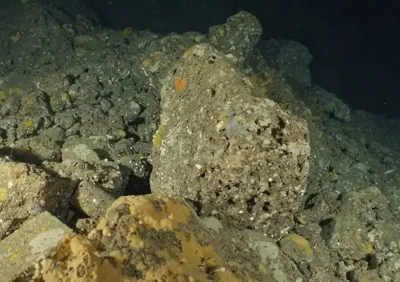 Capri - Recent underwater surveys, led by the Superintendency of Archaeology, Fine Arts and Landscape for the Metropolitan Area of Naples, have discovered a submerged worked stone block resting on the seabed in the Blue Grotto. The Blue Grotto is a sea cave on the coast of the island of Capri, famous for the blue glowing water created by sunlight that shines through the narrow arched entrance way and an underwater cavity. During antiquity, the grotto served as Emperor Tiberius’s private swimming spot (reigning from AD 14 to 37). He commissioned the construction of an Imperial nymphaeum within the cave, adorned with various statues, including depictions of the Roman gods. Underwater excavations during the 1960’s, found three statues of the Roman sea gods, Neptune and Triton, which are now on display at a museum in Anacapri. Seven bases of statues were also recovered from the grotto floor in 2009. The nymphaeum is also linked with the Villa di Gradola, situated directly above the Blue Grotto. This villa is believed to be one of the twelve villas of Tiberius on the island, as documented by the Roman historian Tacitus. In a press announcement by the Superintendency of Archaeology, Fine Arts, and Landscape for the Metropolitan Area of Naples, archaeologists have identified a worked stone block at a depth of 3 metres beneath the water surface, suggested to be a sculptural furnishing of the imperial nymphaeum. Using balloons, divers carefully maneuvered the stone block through the cave opening, which has been sent to the port of Capri for further study.
Capri - Recent underwater surveys, led by the Superintendency of Archaeology, Fine Arts and Landscape for the Metropolitan Area of Naples, have discovered a submerged worked stone block resting on the seabed in the Blue Grotto. The Blue Grotto is a sea cave on the coast of the island of Capri, famous for the blue glowing water created by sunlight that shines through the narrow arched entrance way and an underwater cavity. During antiquity, the grotto served as Emperor Tiberius’s private swimming spot (reigning from AD 14 to 37). He commissioned the construction of an Imperial nymphaeum within the cave, adorned with various statues, including depictions of the Roman gods. Underwater excavations during the 1960’s, found three statues of the Roman sea gods, Neptune and Triton, which are now on display at a museum in Anacapri. Seven bases of statues were also recovered from the grotto floor in 2009. The nymphaeum is also linked with the Villa di Gradola, situated directly above the Blue Grotto. This villa is believed to be one of the twelve villas of Tiberius on the island, as documented by the Roman historian Tacitus. In a press announcement by the Superintendency of Archaeology, Fine Arts, and Landscape for the Metropolitan Area of Naples, archaeologists have identified a worked stone block at a depth of 3 metres beneath the water surface, suggested to be a sculptural furnishing of the imperial nymphaeum. Using balloons, divers carefully maneuvered the stone block through the cave opening, which has been sent to the port of Capri for further study.
https://www.heritagedaily.com/2024/02/submerged-architectural-element-found-in-blue-grotto/150508
ANGLETERRE – 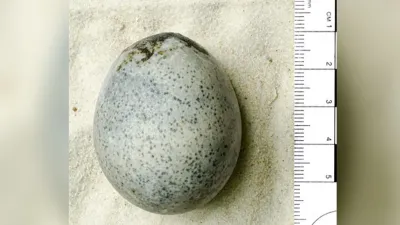 Aylesbury - The only intact chicken's egg found from Roman Britain is now thought to be the only one of its type in the world - after scientists found it still had liquid inside. The egg, which is about 1,700 years old, was found during a dig in Aylesbury in Buckinghamshire. Researchers said at the time it was a "genuinely unique discovery". However, they admitted they were "blown away" recently to find it still contained the yolk and egg white. The egg was found with others during a dig that took place between 2007 and 2016, ahead of a housing development at Berryfields, in Aylesbury. Recent work has been carried out by conservator Dana Goodburn-Brown, who took the egg to the University of Kent to be scanned. "It produced an amazing image that indicated that the egg, apart from being intact - which is incredible enough - also retained its liquid inside, presumably deriving from the yolk, albumen etc," said Mr Biddulph.
Aylesbury - The only intact chicken's egg found from Roman Britain is now thought to be the only one of its type in the world - after scientists found it still had liquid inside. The egg, which is about 1,700 years old, was found during a dig in Aylesbury in Buckinghamshire. Researchers said at the time it was a "genuinely unique discovery". However, they admitted they were "blown away" recently to find it still contained the yolk and egg white. The egg was found with others during a dig that took place between 2007 and 2016, ahead of a housing development at Berryfields, in Aylesbury. Recent work has been carried out by conservator Dana Goodburn-Brown, who took the egg to the University of Kent to be scanned. "It produced an amazing image that indicated that the egg, apart from being intact - which is incredible enough - also retained its liquid inside, presumably deriving from the yolk, albumen etc," said Mr Biddulph.
https://www.bbc.com/news/uk-england-beds-bucks-herts-68247184
ESPAGNE –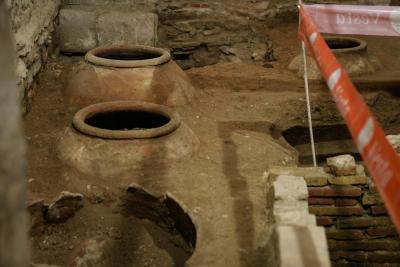
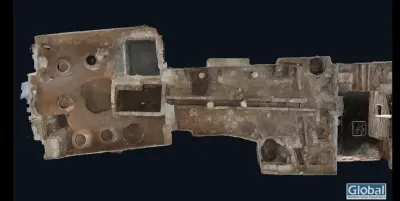 Barcelone - A large medieval house was built 600 years ago in Barcelona, Spain. By the 19th century, it was a chocolate factory. Now, archaeologists are exploring the remains of the ancient building, revealing artifacts from the structure’s various uses, according to a Feb. 12 news release from the Barcelona Archaeology Service. Experts said the remains of the estate they found date to the 19th century, but further exploration revealed walls with arches and doors from a medieval home built in the 14th century.
Barcelone - A large medieval house was built 600 years ago in Barcelona, Spain. By the 19th century, it was a chocolate factory. Now, archaeologists are exploring the remains of the ancient building, revealing artifacts from the structure’s various uses, according to a Feb. 12 news release from the Barcelona Archaeology Service. Experts said the remains of the estate they found date to the 19th century, but further exploration revealed walls with arches and doors from a medieval home built in the 14th century.
https://news.yahoo.com/ancient-chocolate-factory-built-600-173058613.html
BULGARIE – 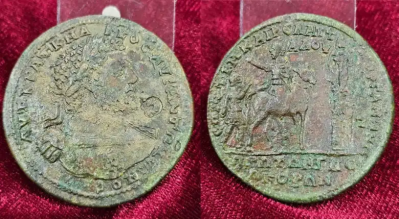 Nova Varbovka - One of the valuable discoveries from the Roman tombs discovered near the village of Nova Varbovka in Strazhitsa municipality in the Veliko Turnovo region of Bulgaria in late 2023 was a medallion of the Roman emperor Caracalla (198 to 217 CE). The Caracalla medallion, made of bronze, was struck in the city of Pergamon in Asia Minor (modern-day Türkiye ). On one side is a scene from the emperor’s visit in 214 to Pergamon, where he sought healing from the god of medicine Asclepius. The museum said that the medallion has a high financial value, but given its size, was not used in everyday trade. The inscriptions are in ancient Greek. The Roman graves were accidentally found in autumn by a tractor driver who, while plowing a field near the village of Nova Varbovka, hit a limestone slab. The funerary objects – jewelry, coins, and vessels – found date back to the first half of the 3rd century AD. The tombs’ walls are covered in fine porcelain plaster, and one of them is shaped like an unusual brick pillow on the floor. A ceremonial ceramic amphora filled with wine is located above one of the tombs. Two adults were interred in one tomb: a man between the ages of 50 and 60 and a woman between the ages of 45 and 49. The remains of a child between the ages of one and two were discovered in the other tomb. The genders and ages of the buried were determined by Nadezhda Atanassova from the National Institute of Experimental Morphology, Pathology, and Anthropology at the Bulgarian Academy of Science. In the grave of the man and woman were found exquisite gold women’s earrings, a gilt pendant with a bead, and a silver-plated fibula of several types of metal. Also, on the man’s chest, there was a silver coin (denarius) minted in the city of Laodicea. It is believed that the deceased were wealthy landowners with properties in the territory administered by the ancient city of Nicopolis ad Istrum. Gifts were found with the child, including a pair of small gold earrings, children’s glass bead jewelry, a ceramic amphora for wine, and two glass lacrimaria – exquisite vessels used to collect mourners’ tears and later used for fragrant oils.
Nova Varbovka - One of the valuable discoveries from the Roman tombs discovered near the village of Nova Varbovka in Strazhitsa municipality in the Veliko Turnovo region of Bulgaria in late 2023 was a medallion of the Roman emperor Caracalla (198 to 217 CE). The Caracalla medallion, made of bronze, was struck in the city of Pergamon in Asia Minor (modern-day Türkiye ). On one side is a scene from the emperor’s visit in 214 to Pergamon, where he sought healing from the god of medicine Asclepius. The museum said that the medallion has a high financial value, but given its size, was not used in everyday trade. The inscriptions are in ancient Greek. The Roman graves were accidentally found in autumn by a tractor driver who, while plowing a field near the village of Nova Varbovka, hit a limestone slab. The funerary objects – jewelry, coins, and vessels – found date back to the first half of the 3rd century AD. The tombs’ walls are covered in fine porcelain plaster, and one of them is shaped like an unusual brick pillow on the floor. A ceremonial ceramic amphora filled with wine is located above one of the tombs. Two adults were interred in one tomb: a man between the ages of 50 and 60 and a woman between the ages of 45 and 49. The remains of a child between the ages of one and two were discovered in the other tomb. The genders and ages of the buried were determined by Nadezhda Atanassova from the National Institute of Experimental Morphology, Pathology, and Anthropology at the Bulgarian Academy of Science. In the grave of the man and woman were found exquisite gold women’s earrings, a gilt pendant with a bead, and a silver-plated fibula of several types of metal. Also, on the man’s chest, there was a silver coin (denarius) minted in the city of Laodicea. It is believed that the deceased were wealthy landowners with properties in the territory administered by the ancient city of Nicopolis ad Istrum. Gifts were found with the child, including a pair of small gold earrings, children’s glass bead jewelry, a ceramic amphora for wine, and two glass lacrimaria – exquisite vessels used to collect mourners’ tears and later used for fragrant oils.
ALLEMAGNE – 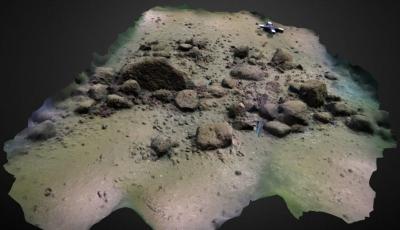
 Mecklenburg - Hiding deep beneath the Baltic Sea, an architectural wonder of the Stone Age has been discovered by researchers. This megastructure, which is situated 21 meters (69 feet) below the surface of the sea in Germany’s Bay of Mecklenburg, is thought to be over 10,000 years old. It is almost a kilometer (0.62 miles) long and is made up of big stones that have been thoughtfully placed. The wall, which may be the largest Stone Age megastructure in Europe, is believed to have been constructed some 11,000 years ago to direct reindeer into areas where they could be killed more easily. The German research team, led by geophysicist Jacob Geersen of Kiel University, hypothesizes that the structure was part of a wall used by ancient hunter-gatherers for hunting. The structure has been named the Blinkerwall. Researchers used a combination of ships and submarine drones to survey the area, collecting sonar data on the shape and size of the long-lost structure. The sheer number of rocks, as well as their organized placement, told the researchers that the formation was not crafted by natural processes. Tectonic movements, erosion, and changes in climate, including sea level and glaciation, have all contributed to the gradual shifting of Earth’s landscape over time, resulting in the sea swallowing up numerous coastal settlements and structures. Technological advances have now made it possible to discover these lost structures. While the Blinkerwall was on dry land around 10,000 years following the end of the last Ice Age. However, it was ultimately flooded due to sea level rise sometime between 8,600 to 8,000 years ago. Examination of the site indicates 1,670 stones organized over a 971-meter (3,186-foot) stretch, with each stone being under a meter in height and 2 meters in width. So the team thinks the structure was built by linking large stones that were too heavy to move with smaller stones that could be shifted. The researchers rule out the Blinkerwall being used as a fish weir or coastal defense because the structure does not meet the requirements for these uses, despite its proximity to an ancient shoreline or bog. Instead, they suggest that the wall could have been used to corral large animals like reindeer or bison for hunting. Team member Marcel Bradtmöller, an archaeologist at the University of Rostock, believes it was probably made by hunter-gatherers belonging to what is known as the Kongemose culture, named after a site in Denmark where artifacts such as stone tools have been found. The Kongemose culture (Kongemosekulturen) was a mesolithic hunter-gatherer culture in southern Scandinavia ca. 6000 BC–5200 BC and the origin of the Ertebølle culture. Similar low walls, also known as desert kites, have been discovered under the Great Lakes in North America, as well as in numerous locations throughout Africa and the Middle East. Some are up to 5 kilometers long, and it is now widely accepted that they were used for hunting. The new study is published in the journal Proceedings of the National Academy of Sciences.
Mecklenburg - Hiding deep beneath the Baltic Sea, an architectural wonder of the Stone Age has been discovered by researchers. This megastructure, which is situated 21 meters (69 feet) below the surface of the sea in Germany’s Bay of Mecklenburg, is thought to be over 10,000 years old. It is almost a kilometer (0.62 miles) long and is made up of big stones that have been thoughtfully placed. The wall, which may be the largest Stone Age megastructure in Europe, is believed to have been constructed some 11,000 years ago to direct reindeer into areas where they could be killed more easily. The German research team, led by geophysicist Jacob Geersen of Kiel University, hypothesizes that the structure was part of a wall used by ancient hunter-gatherers for hunting. The structure has been named the Blinkerwall. Researchers used a combination of ships and submarine drones to survey the area, collecting sonar data on the shape and size of the long-lost structure. The sheer number of rocks, as well as their organized placement, told the researchers that the formation was not crafted by natural processes. Tectonic movements, erosion, and changes in climate, including sea level and glaciation, have all contributed to the gradual shifting of Earth’s landscape over time, resulting in the sea swallowing up numerous coastal settlements and structures. Technological advances have now made it possible to discover these lost structures. While the Blinkerwall was on dry land around 10,000 years following the end of the last Ice Age. However, it was ultimately flooded due to sea level rise sometime between 8,600 to 8,000 years ago. Examination of the site indicates 1,670 stones organized over a 971-meter (3,186-foot) stretch, with each stone being under a meter in height and 2 meters in width. So the team thinks the structure was built by linking large stones that were too heavy to move with smaller stones that could be shifted. The researchers rule out the Blinkerwall being used as a fish weir or coastal defense because the structure does not meet the requirements for these uses, despite its proximity to an ancient shoreline or bog. Instead, they suggest that the wall could have been used to corral large animals like reindeer or bison for hunting. Team member Marcel Bradtmöller, an archaeologist at the University of Rostock, believes it was probably made by hunter-gatherers belonging to what is known as the Kongemose culture, named after a site in Denmark where artifacts such as stone tools have been found. The Kongemose culture (Kongemosekulturen) was a mesolithic hunter-gatherer culture in southern Scandinavia ca. 6000 BC–5200 BC and the origin of the Ertebølle culture. Similar low walls, also known as desert kites, have been discovered under the Great Lakes in North America, as well as in numerous locations throughout Africa and the Middle East. Some are up to 5 kilometers long, and it is now widely accepted that they were used for hunting. The new study is published in the journal Proceedings of the National Academy of Sciences.